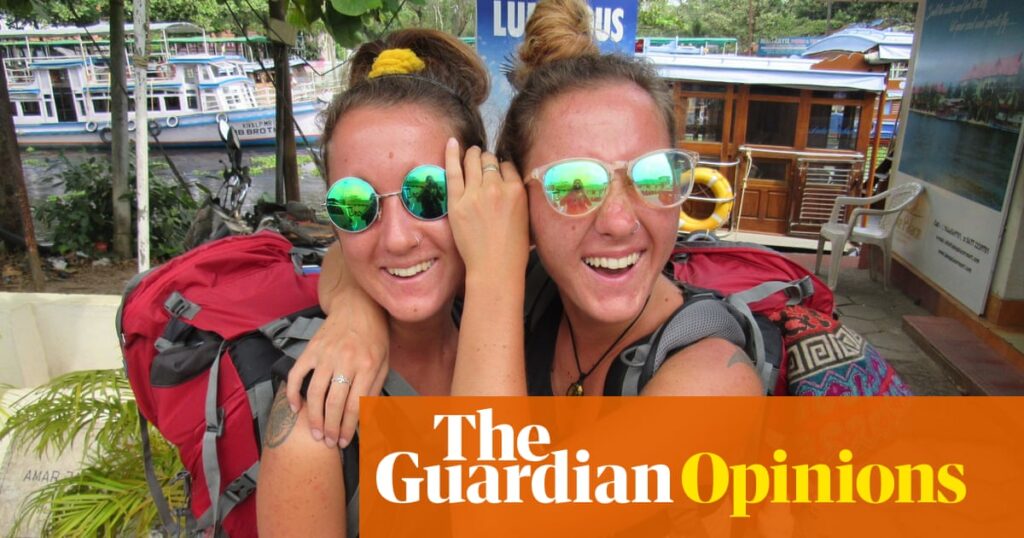“Why are you fat, and why is she thin,” a puzzled middle-aged man asked, as my identical twin Katy and I strolled into a restaurant in central Mumbai for a post-yoga samosa. It wasn’t the first time we had been asked this question – but each time it hurt just as much, and stoked a decades-long resentment towards my sister, who was always being told she was better looking than me.
As children, we had relished in our identicalness and were joined at the hip. Physically, the only way people (even family members) could tell us apart was by our face shape. I had a slightly rounder face than Katy, with chubby cheeks that earned me the nickname Chipmunk growing up. Katy and I got the same grades, had the same interests, and on birthdays and Christmases got given identical gifts – but in different colours. We were inextricably “one”.
But when we were 13, the cracks began to show. At secondary school we begrudgingly agreed to be separated into different classes, forcing both of us to stand on our own feet for the first time. As the more naive sister, I trusted that our separation would be good for us in time – that it might help us to forge our own individuality within our closeness. Katy, on the other hand, struggled with her newfound independence.
It began with a skipped meal here and there, and an extra walk around the block at lunchtime. After a few months of restrictive dieting and obsessive exercising, Katy had started to lose weight, and a close family member noticed the stark difference in physical appearance between the two of us. Suddenly, we weren’t identical any more.
Over the next seven years, Katy was in and out of psychiatric units across the country, being treated for anorexia. I expressed my grief through frustrated, teary outbursts where I begged her to “just eat, like a normal person”. I would visit her after school, at weekends and in the holidays, feeling abandoned, lost and rejected. We refer to this period of our life as the years we “hated each other”. I hated the fact I couldn’t live my life as a “normal” teenager, and she hated how much I hated her.
As Katy recovered, our relationship improved. But comments on our physical differences persisted, and they started to affect me. One guy at a party even dared to say to his friend, in earshot: “I’m more attracted to Katy because she’s thinner than Lara.” Our trip to India together had been about trying to repair our fractious bond and embark on yoga teacher training together – but the comments followed us there, too.
I realised all the resentment I had been carrying for the past seven years was starting to express itself in a self-destructive and toxic way. I had started to hate myself. I felt less than, invisible, and defeated by my sister’s illness; as if I could never just be enough the way I am. I entertained fantasies that she would always be the more attractive, thinner twin that everyone rallied around. My self-worth had evaporated and I started to lose weight. For two years, we became competitors.
But when our dad died three years ago, it was like a switch flicked in my brain. I realised that life was too short to keep comparing myself with my sister, and tying my identity and self-worth to our identicalness.
I read self-help books religiously to try to improve my body image and self-esteem, like Health at Every Size and Women Don’t Owe you Pretty. I listened to podcasts like Seems Like Diet Culture and ritualised cringe-worthy daily affirmations that I performed in the mirror.
Now, when people comment on our differences, the result is night and day. Sometimes I still feel insecure, but there are more liberating moments, too, when I think, “Well, what’s wrong with being bigger than my twin sister, anyway?” It was only when I stopped feeling like the victim of other people’s judgments – which are ultimately out of my control – that I finally stopped comparing my weight, size and perceived attractiveness with my twin sister. In doing so, I was able to regain the self-confidence I once had, and finally allow our twinship to truly thrive.
Do you have an opinion on the issues raised in this article? If you would like to submit a response of up to 300 words by email to be considered for publication in our letters section, please click here.

